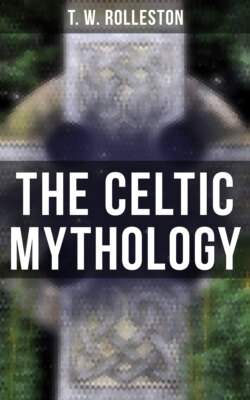Читать книгу The Celtic Mythology - T. W. Rolleston - Страница 44
На сайте Литреса книга снята с продажи.
The Tumulus at New Grange
ОглавлениеOne of the most important and richly sculptured of European megalithic monuments is the great chambered tumulus of New Grange, on the northern bank of the Boyne, in Ireland. This tumulus, and the others which occur in its neighbourhood, appear in ancient Irish mythical literature in two different characters, the union of which is significant. They are regarded on the one hand as the dwelling-places of the Sidhe (pronounced Shee), or Fairy Folk, who represent, probably, the deities of the ancient Irish, and they are also, traditionally, the burial-places of the Celtic High Kings of pagan Ireland. The story of the burial of King Cormac, who was supposed to have heard of the Christian faith long before it was actually preached in Ireland by St. Patrick and who ordered that he should not be buried at the royal cemetery by the Boyne, on account of its pagan associations, points to the view that this place was the centre of a pagan cult involving more than merely the interment of royal personages in its precincts. Unfortunately these monuments are not intact; they were opened and plundered by the Danes in the ninth century,43 but enough evidence remains to show that they were sepulchral in their origin, and were also associated with the cult of a primitive religion. The most important of them, the tumulus of New Grange, has been thoroughly explored and described by Mr. George Coffey, keeper of the collection of Celtic antiquities in the National Museum, Dublin.44 It appears from the outside like a large mound, or knoll, now overgrown with bushes. It measures about 280 feet across, at its greatest diameter, and is about 44 feet in height. Outside it there runs a wide circle of standing stones originally, it would seem, thirty-five in number. Inside this circle is a ditch and rampart, and on top of this rampart was laid a circular curb of great stones 8 to 10 feet long, laid on edge, and confining what has proved to be a huge mound of loose stones, now overgrown, as we have said, with grass and bushes. It is in the interior of this mound that the interest of the monument lies. Towards the end of the seventeenth century some workmen who were getting road-material from the mound came across the entrance to a passage which led into the interior, and was marked by the fact that the boundary stone below it is richly carved with spirals and lozenges. This entrance faces exactly south-east. The passage is formed of upright slabs of unhewn stone roofed with similar slabs, and varies from nearly 5 feet to 7 feet 10 inches in height; it is about 3 feet wide, and runs for 62 feet straight into the heart of the mound. Here it ends in a cruciform chamber, 20 feet high, the roof, a kind of dome, being formed of large flat stones, overlapping inwards till they almost meet at the top, where a large flat stone covers all. In each of the three recesses of the cruciform chamber there stands a large stone basin, or rude sarcophagus, but not traces of any burial now remains.
